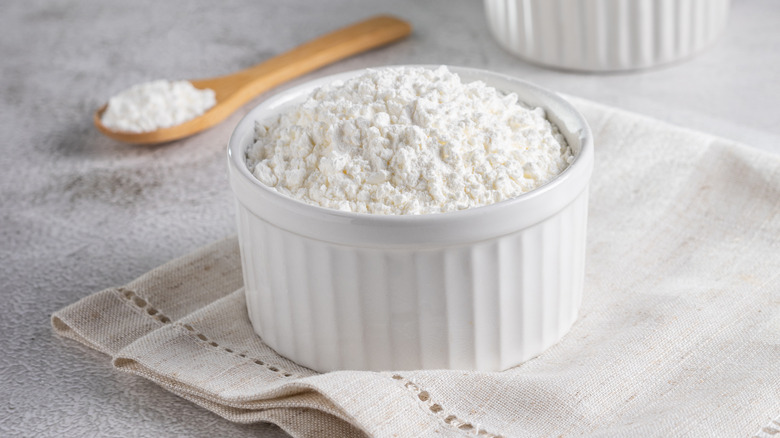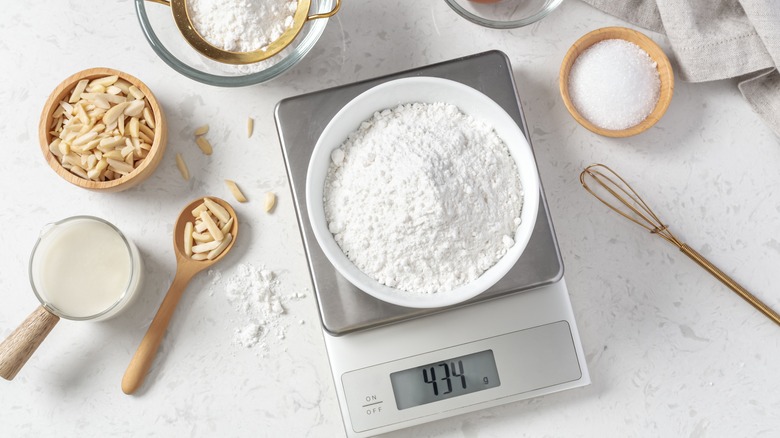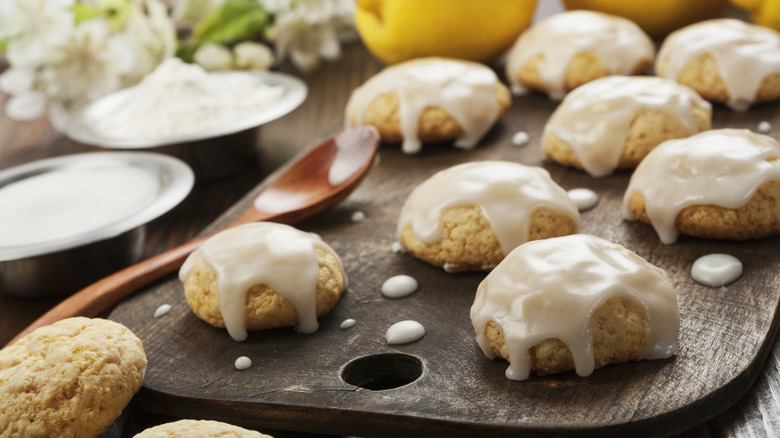11 Ways To Recreate Crumbl-Style Cookies At Home
When Crumbl Cookies was founded in 2017, it must have been hard to imagine that it would grow to be the nationwide cookie phenomenon that it is today. Nevertheless, the cookie company's massive, creative cookies have since taken the country by storm — and for good reason. Not only are the cookies (which are frequently loaded up with frostings, glazes, and other inventive toppings) remarkable, but the way the company markets its products is fantastic. Crumbl releases six cookie flavors weekly, and while one stays the same (usually a version of the classic chocolate chip), the other five rotate. So, it's hard to predict what cookie flavors are coming next.
Considering the viral popularity of the cookie company, it's a given that bakers around the country would try their hands at creating spot-on dupes of the best Crumbl cookies. Though the company is tight-lipped about its formulas, clever bakers have used their knowledge of baking chemistry to create Crumbl lookalikes — and, unlike the company, they're sharing their recipes with anyone who wants to try their hand at it. As a lifelong baker who's especially fond of cookies, I have some tricks up my sleeve to help your cookies come out thick, chewy, and decadent — just like the ones you'd find at Crumbl. I also consulted other bakers to see how they're trying to recreate the famous cookies. Using some of these tricks of the trade, along with some clever baking additions and substitutions, can go a long way in making your homemade cookies taste like they came from the store.
1. Don't over mix your cookies after adding mix-ins
My first tip to help you create thick, chewy cookies that aren't dense is a simple one: Don't over-mix your cookie dough after adding your dry ingredients. In fact, you should never over-mix dough when you're baking. This is particularly important to keep in mind if you're adding any final mix-ins to the equation, like chocolate chips, nuts, or sprinkles. It's best to add these extras just before your dry ingredients are fully blended into the dough. Therefore, they can be stirred into the dough without the risk of over-mixing it.
You're probably wondering, what's so bad about over-mixing? From the moment you combine flour and moisture, gluten starts to develop. This is great if you're kneading a dough to make bread, but not so great if you're after delicate desserts like cookies or cakes. Too much gluten development spells bad news for your Crumbl-esque cookies; it will cause them to turn out dense and tough, rather than soft and chewy. You'll want to mix your dry ingredients only until they're no longer visible in the dough. Keep in mind that this tip only applies once you've added the dry ingredients. The previous steps, like creaming together butter and sugar, should be done thoroughly (until the mixture is fluffy and lighter in color) to incorporate enough air into the dough.
2. Be generous with vanilla
I've achieved some fantastic flavor results in my cookies through a surprisingly simple hack: adding more vanilla. While the dash of vanilla typically called for in a recipe does just enough to accentuate the cookie's flavor, adding more than the amount called for — double or even triple — can blow your cookie's flavor out of the water. If you decide to use this tip, though, make sure you're using a high-quality vanilla to get the best results. I recommend Nielsen-Massey's Madagascar bourbon vanilla extract. Stay away from vanillas that are labeled "imitation vanilla" or "vanilla flavoring," as those tend to have a less potent flavor. Want to go one step further? Try swapping vanilla extract with bourbon vanilla bean paste for an even richer-tasting vanilla.
I recommend adding vanilla to cookies that call for other types of extract, like almond, too. However, I would not advise you to increase the amount of the other extracts in your cookies, as some can be very potent. When your cookies call for extracts other than vanilla, use the amount called for first. Then, after you taste the final product, you can go back and alter your recipe.
These tips for using extract don't apply only to your cookie dough, but to all elements of your homemade Crumbl-style cookie. Play around with varying amounts of vanilla extract in your frosting and glazes, too.
3. Pair your cookies with a thick buttercream frosting
This next tip is a no-brainer, but I have to mention it anyway: You should try topping your cookies with a thick buttercream frosting. You can get creative here and use your frosting to either mimic or slightly deviate from Crumbl's recipe to create something suitable for your palate. For example, Crumbl uses almond extract in the frosting on its sugar cookie. If you're not a huge fan of almond and avoid the cookie for that very reason, you may want to swap this with a simple vanilla buttercream for your homemade cookie.
If you don't like how sweet the chain's cookies can be, you may be wary of adding any buttercream to your homemade cookie. I urge you to give it a try anyway — just be careful not to make your frosting too sweet. The flavor can be mitigated by using high-quality butter and vanilla, adding a touch of salt, and using less powdered sugar in it. You could also make a cream cheese frosting rather than a standard buttercream for a rich, tangy touch. On the other hand, if you find your frosting is longing for an additional sweet element, add caramel to your buttercream to give it a little kick.
4. Don't neglect garnishes
Some Crumbl cookies are instantly recognizable — which is says a lot, considering the number of flavors the chain has released over the years. Yet, sometimes all it takes for fans to realize their favorite flavor is back is a picture. This is particularly true for Crumbl cookies adorned with eye-catching toppings. When you're making these cookies at home, add a garnish to make them more Crumbl-esque.
Not all Crumbl cookies are garnished, but the ones that are use the garnishes to their advantage. Take the chain's caramel apple cookie, for example. Though I'm sure it would taste just as delicious sans accoutrements, the chopped Granny Smith apples and streusel topping take this treat to new heights. The Granny Smith apples, aside from introducing new varied flavor profiles to the cookie, also add a wonderful tartness. And when used well, garnishes can also add a delightful textural contrast to an otherwise perfectly-alright soft, chewy cookie. Even Crumbl cookies that don't boast a host of garnishes benefit from the addition of a non-frosting topping, such as the curd topping on its lemon curd cookie or the glaze on its cornbread cookie. You don't have to stay in the shadow of Crumbl's garnishes, either. Try adding any number of toppings, such as a chocolate truffle garnish or a crumbled toffee topping.
5. Try filling your cookies
If you've ever had one of Crumbl's stuffed cookies, you know that the surprise filling in the center can do a lot to elevate an otherwise pretty average cookie. For example, the chain's Biscoff lavacookie is stuffed with a Biscoff filling that isn't anything particularly fancy, but it still elevates your overall cookie eating experience. Similarly, its hazelnut churro cookie is stuffed with a hazelnut spread, so there's no chance of missing the nutty inclusion.
Making stuffed cookies may seem like a feat, but before you shy away from the challenge, rest assured that it's much easier than you think. In fact, you can stuff a cookie with almost anything you could think of. Firstly, if you want to stuff your cookies with a soft ingredient like Nutella or peanut butter, you'll want to freeze it first to make it easier to work it. Portion it out onto wax or parchment paper in 1 or 2 teaspoon servings and stick in the freezer before you start making the rest of your dough. It doesn't need to be completely frozen, but shouldn't be sticky when you're stuffing your cookies with it. If your stuffing isn't sticky — say you're using M&Ms to stuff a cookie — there's no need to freeze it first. Once you're ready to stuff your cookies, simply portion out your dough, slightly flatten it, add the stuffing, and shape the dough around it.
6. Add cornstarch to your cookies
While I wish I could say I thought up this tip all on my own, but alas, this one came from bakers who have tried time and time again to recreate Crumbl's chewy cookies. Cornstarch is a simple addition can make a world of difference in the texture of your cookie, and it's something every baker should already have in their cupboard. Though it's not known whether Crumbl uses cornstarch in its cookies, the common thickening agent can really help create a convincing dupe.
Adding cornstarch to your cookies will help make them much more softer and tender, and it may also keep them from spreading too much in the oven. The lack of spread will give you a chewier, taller cookie that resembles the ones Crumbl makes. Add a couple teaspoons of cornstarch in when you add your eggs and vanilla, just before you add the flour, and mix it in until it's all blended. Then proceed as usual by adding the flour and mixing the batter. The result should be thick, chewy cookies that could even put Crumbl's cookies to shame.
7. Don't overbake them
Though this tip may seem obvious, it's one I need to state anyway, as it can make or break your attempt at creating a homemade Crumbl cookie. When your cookies are in the oven, take care not to overbake them. Don't let the cookie get golden brown on top, and always set the timer for a couple minutes less that you think they'll need. When your cookies are done baking, they should be very lightly golden brown around the edges and no longer look wet in the middle.
When you pull your cookies from the oven, don't transfer them to a cooling rack right away. Instead, leave them on the cookie sheet for five to 10 minutes. They'll set on the bottom and still hold their shape while remaining soft, thick, and chewy in the middle. If you bake your cookies for too long, you run the risk of them ending up too crunchy and losing the softness that Crumbl cookies are known for. If you're making your cookies as large as Crumbl does, this may take some trial and error. Experiment with oven temperatures and baking times until you achieve your desired results.
8. Experiment with cake flour
The gluten in your flour can affect your finished cookie product. After all, you know not to over-mix your dough, as doing so may cause your cookie to come out tough and dense. Aside from being wary of over-mixing, there's another tip you could try if you want even fluffier, lighter, and airier cookies. As you're playing around with your Crumbl recipes, try substituting all purpose flour for cake flour, which has a lower gluten content.
Because cake flour has less gluten, using it in your cookie recipe will give you a more delicate, tender cookie. I recommend trying cake flour in your cookie recipes at least once, especially if your favorite Crumbl cookies have a cakey (rather than chewy) consistency. If swapping all of the all-purpose flour for cake flour makes your cookies too cake-like, try using half cake flour and half all purpose flour.
9. Weigh the ingredients and dough
Crumbl is understandably tight-lipped about the exact ingredient ratios used in its cookie recipes. In fact, the chain runs no risk of customers spying on the baking process, to such an extent that it makes and uses colored packets containing key ingredients for each cookie rather than having its bakers weigh the ingredients individually. In order to replicate this careful precision and be accurate when baking your recipe, you'll need to utilize a kitchen scale.
If you're testing recipes to try to get as close to a Crumbl cookie as possible, you'll need to weigh your ingredients as you're experimenting and note how much of each ingredient you're using. It will be easier to tweak the recipe for the next time you make it. Weighing your ingredients will also help you achieve consistent results once you do nail the cookie recipe, so your cookies turn out perfect each time. I also recommend weighing your cookie dough balls, especially if you want to make them as big as Crumbl's cookies are. For reference, each Crumbl cookie weighs 5.5 ounces.
10. Let your cookies cool before adding garnishes
Aside from making stellar cookies, if there's one thing Crumb is good at, it's taking temperature into account when it comes to finishing and serving its cookies. If you've ever had a Crumbl cookie that's served chilled or warm, you know exactly what I'm talking about. Temperature can affect how your garnishes and toppings stick to the cookies, so you'll want to use it to your advantage after you take your tray out of the oven. Patience is key here — especially when it comes to adding the finishing touches to your cookies.
First and foremost, though I know you're excited about decorating (and trying) your Crumbl cookie, wait until it's completely cooled before you add any garnishes to it. For example, a thick buttercream frosting will instantly destabilize and start to melt once it's added to a warm cookie. This goes for other finishing touches, too, like candies or caramel. Moreover, sloshing buttercream and melting garnishes won't make your cookies look uniform.
An exception to this rule would be if you're adding a glaze that you want to soak into the cookie. A Crumbl cornbread cookie dupe, for example, should be glazed with the honey butter while it's still warm. The bottom line here is to simply consider how temperature will affect your garnishes before you go ahead and start decorating.
11. Shape your cookies into a slightly oblong ball
Maybe you've followed all the tips and tricks, experimented your heart out, and your attempts at a homemade Crumbl cookie are still falling flat — literally. If you can't achieve the cookie's thick, chewy texture, it could be that you need to shape the cookies differently before you bake them. If your cookies look like they've spread a lot, you may want to try shaping them differently.
Rather than using your cookie scoop, weigh out your dough and then shape it into a slightly oblong ball, almost like a column. The taller shape will keep the cookies from spreading so much in the oven, thus giving you a thicker cookie. If you're concerned about your cookies looking uniform or baking evenly, Nancy Silverton has a chocolate chip cookie hack that uses a similar method. She suggests baking the cookies inside of a ring mold. The ring will contain the dough as it cooks and help it retain its structural integrity. Just remember to grease the molds first so they come off the cookies easily.











